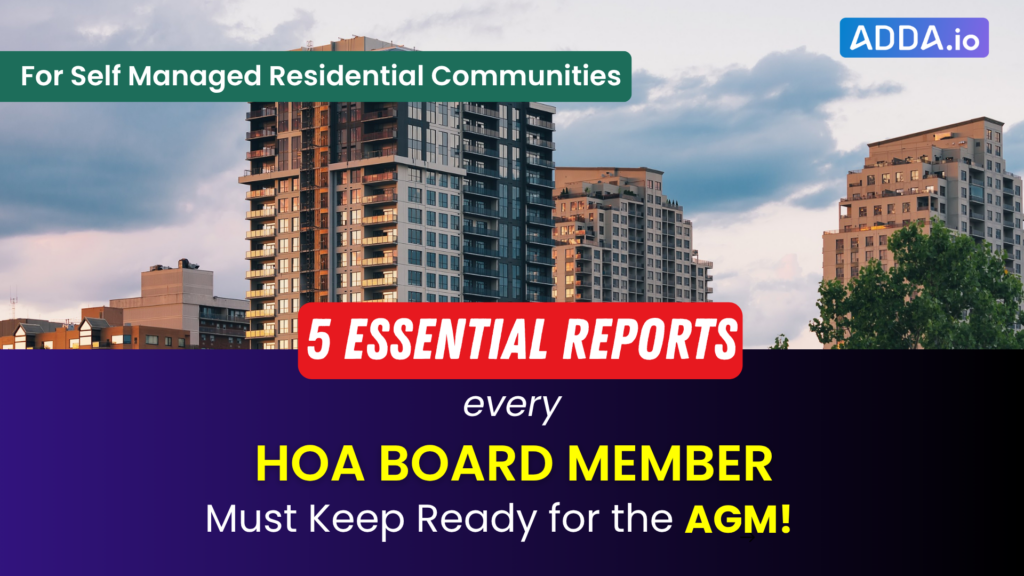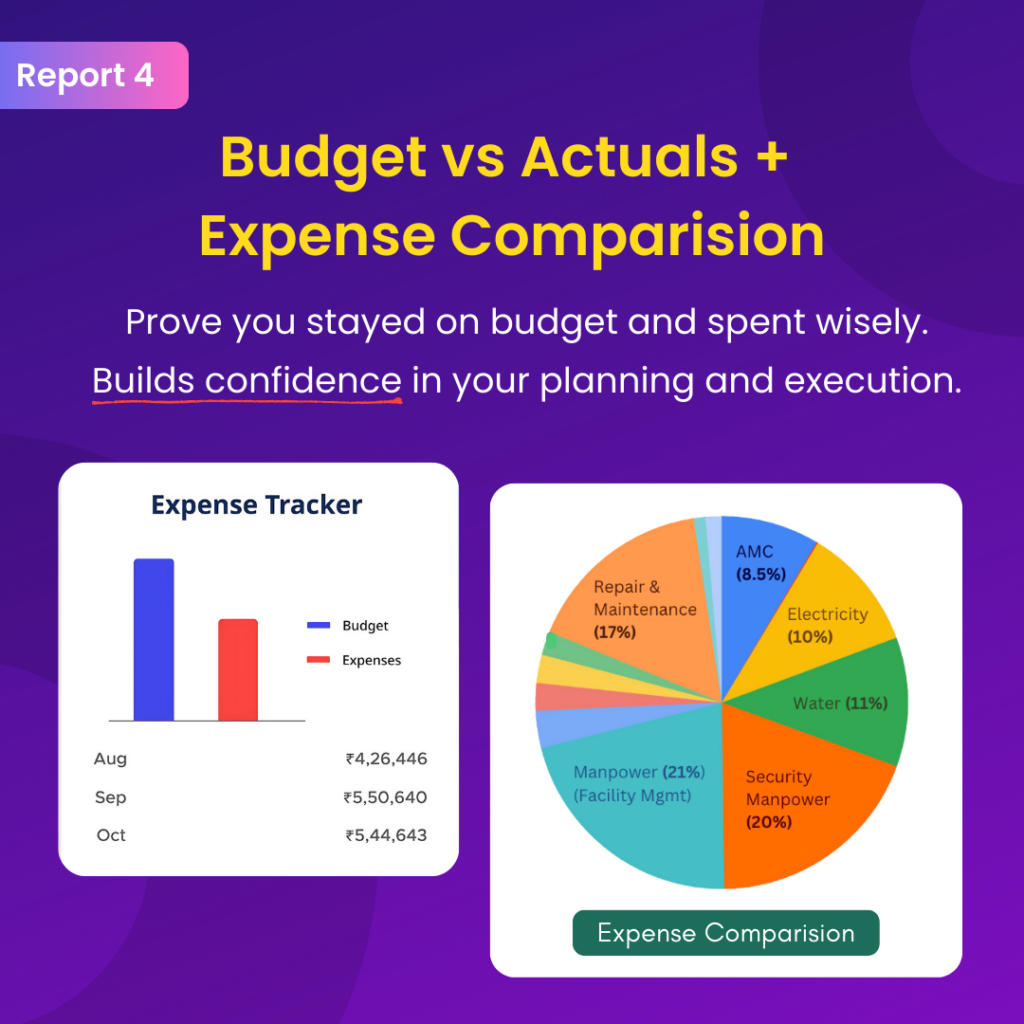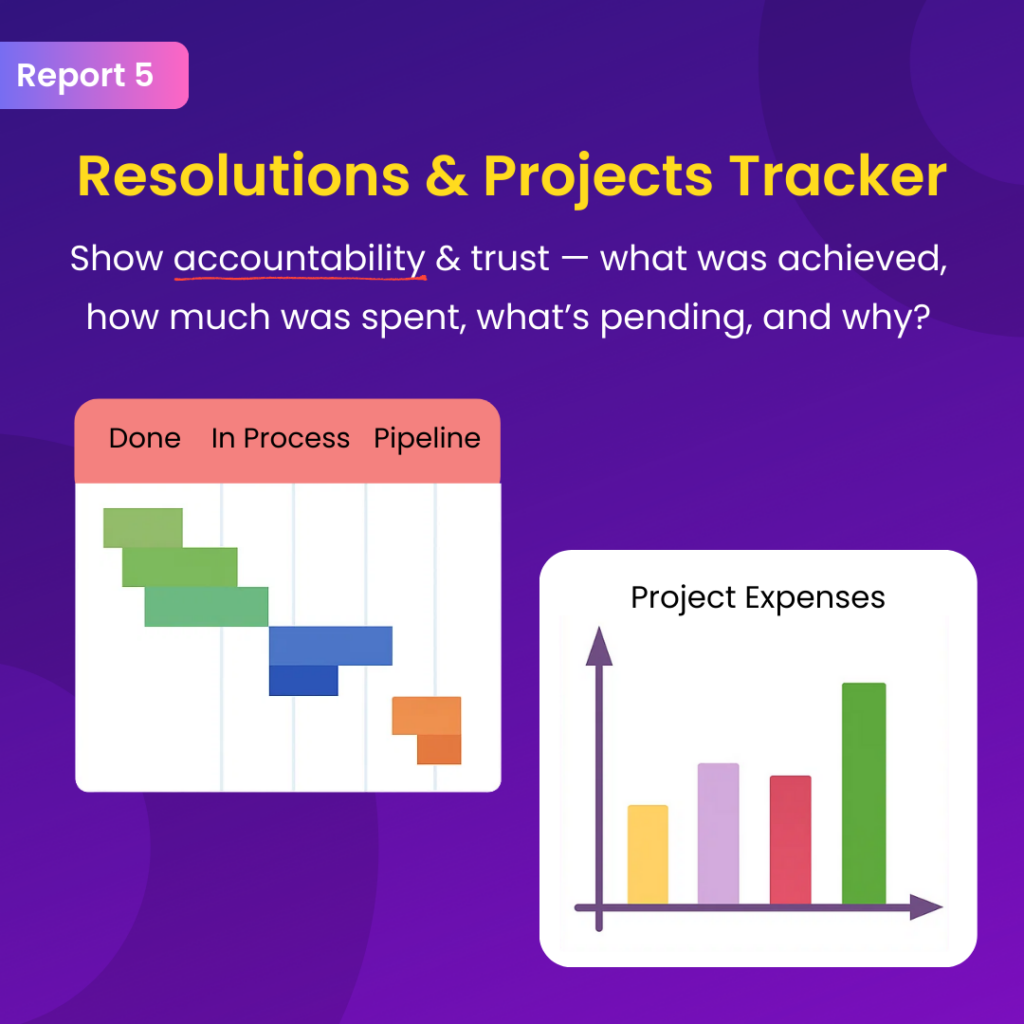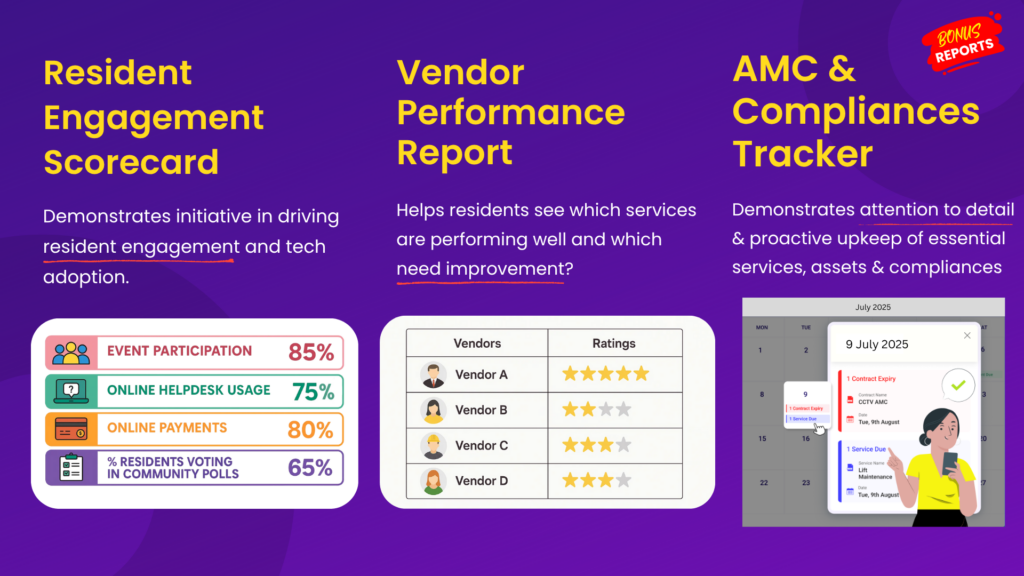A Data-Driven Approach to Transparent, Accountable, and Effective Community Governance

The Annual General Meeting (AGM) is the most critical touchpoint between the HOA Board members and the residents. It’s not just a statutory event—it’s a forum to justify decisions, display results, and align the community on future plans.
HOA Board members are well-intentioned, but many struggle to present data in a structured, clear format. That’s where the right reports make all the difference. With ADDA, these reports are not just available—they’re also easy to generate, understand, and present.
Here’s a breakdown of each must-have report, its role, and how to use it effectively during your AGM.
➡️ Stay tuned till the end to know about 3 essential bonus reports that can give your AGM that extra edge and reinforce your committee’s credibility.

Table of Contents
1. Balance Sheet & Income-Expense Report 📊
This report is the foundation of financial transparency in the AGM. The balance sheet gives a snapshot of the community’s financial position, it highlights all assets held, liabilities owed, and the net reserves. The income-expense report complements it by showing how money was received and spent over the financial year.
During the AGM, this report helps HOA Board Members clearly present all sources of income such as:
- Maintenance charges
- Clubhouse rentals
- Interest earned from FDs—and all expenditures across various heads like salaries, utility payments, minor repairs, or facility maintenance.
- Any surplus or deficit becomes apparent and opens up constructive discussions around managing funds better.
Why It Matters:
This report presents the entire picture of the Community’s financials in a bird’s view – in a single screen. When you present it to the residents, it reflects responsible governance and builds confidence that their money is being well managed. These reports also, serve as a ready reckoner for auditors and ensure regulatory compliance.
2. Helpdesk Performance Report
Resident queries, complaints and service requests are a critical part of daily operations—and how they’re handled reflects directly on the HOA Board Member’s responsiveness and attention to community wellbeing.
The helpdesk performance report captures data on complaints raised, categorized by type (plumbing, electrical, cleanliness, etc.), their resolution times, and whether any escalations took place.
Why this report is essential:
- Helps the HOA Board Member’s showcases operational efficiency. For instance, if most plumbing complaints were closed within one or two days, it demonstrates the efficiency of the plumbing team. If a certain category of issues saw delays, the report helps identify whether it was due to vendor backlogs, unavailability of spares, or staffing gaps.
- Offers a space to reflect on vendor quality—whether housekeeping services consistently meet expectations or if maintenance tasks frequently gets delayed due to rework or other reasons.
- With this report, the HOA Board Member can respond with facts and assure everyone that grievances are being tracked and resolved systematically.
Details which gets included in the reports:
- Category-wise complaints (plumbing, electrical, etc.)
- Turnaround Time (TAT) in days
- Number of unresolved vs resolved issues
- Resident satisfaction scores
3. Billing & Collection Report 📈
This report brings visibility into the collection performance of the community—how much maintenance was billed, how much was collected, and what remains unpaid.
It breaks this information down quarter-wise and often even flat-wise, giving both a macro and micro view of the financial discipline in the community.
What makes this report so vital for the AGM?
- Allows the HOA Board Members to present clear trends over the year—whether there’s been improvement in collection rates, or if defaults have become more frequent.
- Gives the HOA Board Member an opportunity to explain how late payments affect the day-to-day operations of the society. If the association has had to delay payments to security vendors or postpone repair work, this report helps connect the dots.
- It’s also helpful when proposing measures like late payment penalties, offering discounts for early payers, or initiating legal notices for long-term defaulters.
- More importantly, it positions the HOA Board Member as transparent and data-driven when dealing with resident finances.
Details which gets included in the reports::
- Quarterly collection rates
- Number of defaulters
- Trends over the year
- Action steps for chronic defaulters
4. Expense Reports – Budget vs Actuals + Expense Comparison
The Budget Vs Actuals report compares the budget set at the beginning of the financial year with the actual expenses incurred across all heads.
It includes routine operational categories like housekeeping and security, as well as project-based expenditures like repainting buildings or equipment upgrades.
When presented effectively, this report shows:
- How close or far the HOA Board Member stayed within the planned financial limits.
- If there are overruns, they are backed by context—perhaps the community had to undertake emergency plumbing work, or AMC costs went up mid-year.
- On the other hand, if some areas saw under-spending, it opens up discussions about reallocation or deferred needs.
- Helps set expectations for the coming year. If the HOA Board Members consistently stayed under budget, it reflects strong cost control. If certain categories always exceed estimates, it signals a need to revise budget assumptions.

Must-Highlight Sections:
- Budgeted vs Actual spend per category (e.g., repairs, salaries, events)
- Comparison of expenses across different categories
- Deviations and reasons (e.g., emergency works)
5. Project Expenses & Resolutions Tracker
Many HOA Board Member’s begin their term with a vision—upgrading the gym, painting the tower exteriors, installing EV charging, and so on. This report tracks the status and cost of all such projects along with AGM-passed or committee-level resolutions from the year.
Why it is needed:
- What has been completed, what is in process, what remains in the pipeline, and the exact reasons behind delays or shifts in priority. If a project has gone over budget, the tracker explains whether the cost increased due to inflation, material changes, or vendor issues.
- This report is also helpful during HOA Board Member’s handovers. Future committees can see what work is already underway, what’s been closed, and where to pick up the thread. It avoids duplication of efforts and confusion.
- In the AGM, it gives the current HOA Board Member a chance to walk residents through a year’s worth of execution, acknowledge gaps, and set expectations clearly.

Details which gets included in the reports:
- Completed projects (e.g., lift upgrade, CCTV, painting)
- Ongoing and pipeline projects
- Cost against budget for each
- Roadblocks and explanations for delays
Bonus Reports (Highly Recommended)
- Resident Engagement Scorecard
Tracks how actively residents participate in events, polls, and digital forums. High participation reflects community trust and connectivity. The HOA Board Member can use this to propose more inclusive programs or app-based voting for decisions.
This report also shows the digital adoption of the community. If your community residents are raising most of their helpdesk requests online, if they are making most of their maintenance payments online, then it is in turn saving a ton of time for the community management staff.
This report bring out all of these aspects.
- Vendor Performance Report
Gives insight into how service providers have performed throughout the year, based on SLAs, complaint resolution, and resident feedback. It provides rationale for contract renewals or terminations and supports better negotiation.
- AMC & Compliance Tracker
Ensures the community remains legally and operationally up to date. It logs all Annual Maintenance Contracts and inspections for facilities like lifts, generators, fire systems, and STPs. Bringing this to the AGM avoids last-minute panic and shows residents that critical upkeep is under control.
✅ MC Benefit: Having these reports ready saves time during the AGM and builds instant trust with residents.

Conduct Your AGM Like a Rockstar with ADDA!
With ADDA, generating these essential reports becomes seamless and efficient. Each report is available through one-click access, allowing HOA Board Members members to shift their focus from time-consuming administrative tasks to strategic leadership and community engagement.
Say goodbye to manual spreadsheets and last-minute data gathering. Instead, present well-structured, audit-ready reports that reflect professionalism, transparency, and a commitment to excellence—exactly what residents expect and appreciate.
Need Help?
We’re here to support you at: support@adda.io
🌐 Visit: www.adda.io